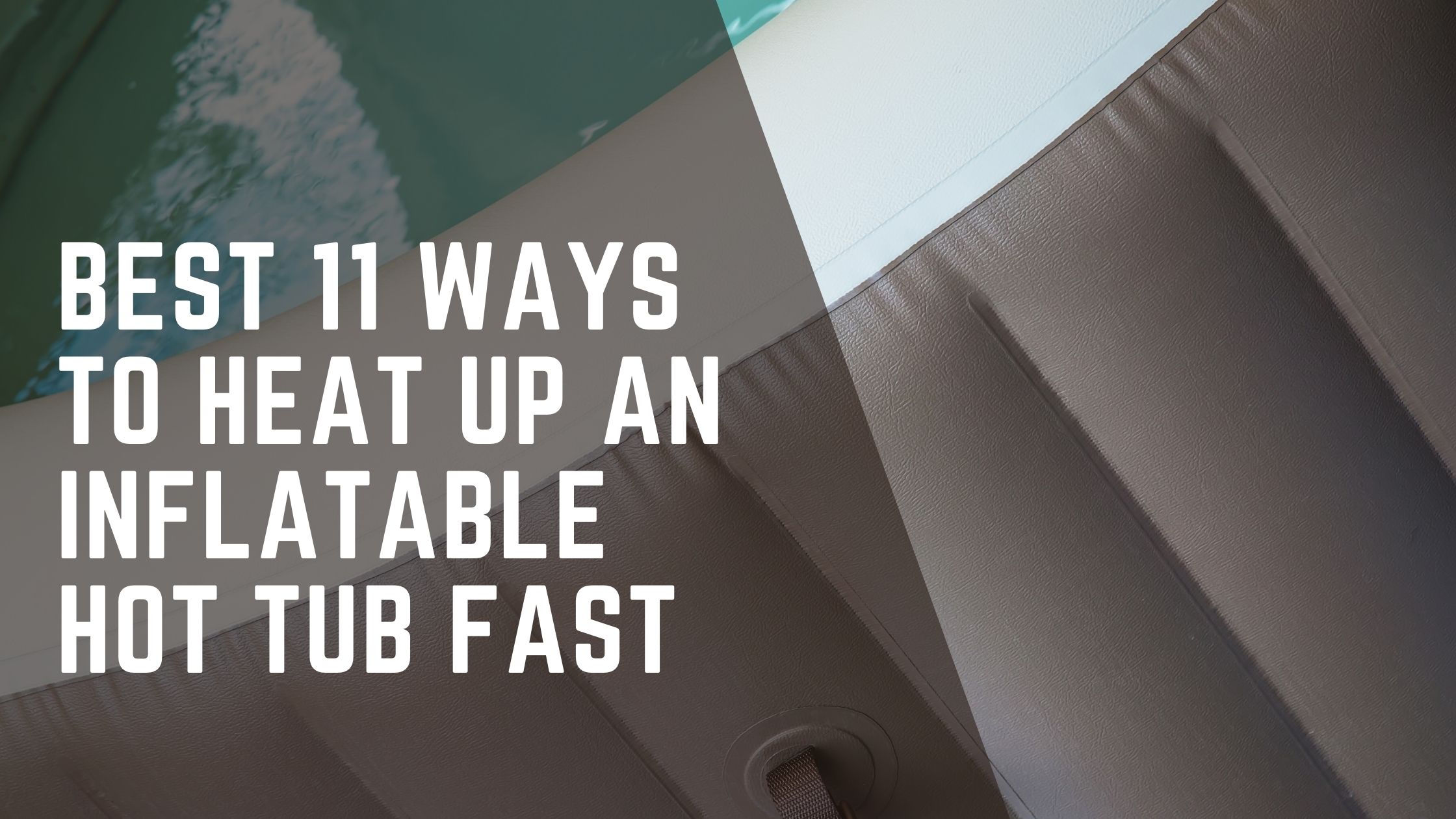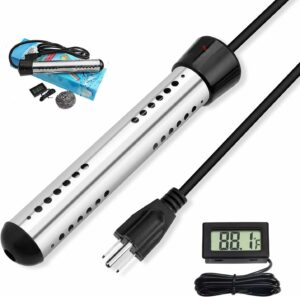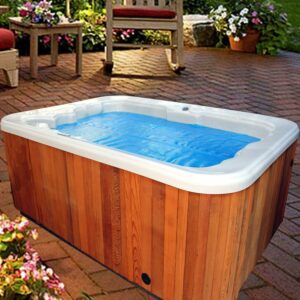Heating up an inflatable hot tub quickly is a common challenge for many owners. As someone who frequently enjoys the soothing embrace of my inflatable spa, I’ve experimented with various techniques to speed up the heating process. Today, I’ll share with you 11 effective ways to get your inflatable hot tub ready faster, so you can dive into relaxation without the lengthy wait.
1. Utilize a Portable Immersion Heater
For an extra boost in heating, consider using a portable immersion heater. These heaters can be submerged directly into the water, providing additional heat alongside your main heater. It’s a quick fix that can significantly reduce heating time. However, make sure to use a model that is safe for use in inflatable hot tubs to avoid any risk of damage to the tub or safety hazards.
2. Use a High-Quality Insulated Cover
One of the simplest yet most effective methods to speed up your hot tub’s heating time is to use a high-quality insulated cover. This cover helps retain heat, preventing heat loss to the environment. I’ve found that a good cover can significantly reduce heating time and also keep the water warm for longer periods.
3. Place on an Insulated Ground Mat
Before setting up your hot tub, place an insulated ground mat beneath it. This mat acts as a barrier against the cold ground, which can absorb a significant amount of heat from your hot tub. An insulated mat can make a noticeable difference, especially in cooler climates.
4. Use a Wind Block
Wind can dramatically increase heat loss. By setting up a wind block around your hot tub, you can keep the wind at bay and reduce the cooling effect it has. This can be anything from a hot tub enclosure to simple privacy screens or even strategically placed garden furniture.
5. Preheat Water During Filling
Instead of filling your hot tub with cold water from the hose, try filling it with warm water if your home’s plumbing allows. This can reduce the initial heating demand on your hot tub’s heater and get you soaking sooner.
6. Solar Water Heating Bags
Invest in solar water heating bags or panels. Place them in the sun and then transfer the heated water into your hot tub. This eco-friendly method can effectively raise the water temperature and reduce reliance on the built-in heater.
7. Upgrade the Heater
If you find the standard heater that came with your hot tub lacking, consider upgrading to a more powerful model. This is particularly useful for larger hot tubs or for use in colder regions where heating demands are greater.
8. Optimize Heating Time
Running the heater during the warmest part of the day can capitalize on ambient temperatures, thus aiding the heating process. Conversely, avoid heating during colder times like early mornings or late evenings.
9. Use a Heat Pump
Heat pumps are an excellent investment for regular hot tub users. They can heat water quickly and more economically in the long run. Though the initial setup cost is higher, the efficiency and speed can be worth it.
10. Reduce Water Volume
If you’re not expecting many guests, consider filling the hot tub with less water. Less water means quicker heating, which is perfect for a solo soak or a couple’s retreat.
11. Chemical Maintenance
Keep your water chemistry balanced. Properly maintained water not only ensures a healthier soak but also aids in heat retention. Imbalanced pH levels can lead to inefficiencies and potentially damage your heating system over time.
12. Use a Floating Thermal Blanket
A floating thermal blanket can be used underneath the main cover. This blanket adds an extra layer of insulation, significantly reducing heat loss and thus speeding up the heating process.
13. Fully Insulate the Hot Tub
To maximize heat retention, it’s essential to insulate not just the top of your hot tub but also the sides and the bottom. You can use specialized hot tub insulation wraps or even foam pads that wrap around the exterior. This comprehensive insulation acts like a cozy blanket, significantly minimizing heat loss and speeding up the heating process. From my experience, this method is especially beneficial during colder months, making it a staple in my winter hot tub preparations.
14. Fill It with Warm Water (But Not Too Hot!)
As mentioned earlier, filling your hot tub with warm water can give you a head start on heating. However, it’s important to ensure that the water is not too hot as it can damage the structural integrity of the hot tub or adversely affect the water chemistry. Aim for lukewarm water that feels warm to the touch but not hot. This method reduces the workload on your hot tub’s heater and allows you to enjoy your hot tub much quicker.
15. Enclose with a Pop-Up Canopy Tent
Using a pop-up canopy tent over your inflatable hot tub can create a microclimate that significantly retains heat. The tent acts as a barrier against the cold, trapping warmth inside while also protecting you from elements like wind and light rain. This setup has been a game changer for me, particularly for enjoying a warm soak even on breezy days. It’s a simple, quick solution that enhances both privacy and warmth.
heating up inflatable hot tub quickly FAQs
Does Hot Tub Heat Up Faster With Jets On
Interestingly, turning on the jets in your hot tub can indeed help it heat up faster. The jets promote water movement, facilitating a more even distribution of heat throughout the tub. This action helps the heat penetrate more areas of the water quicker than if the water were still. Additionally, the jets can aid in breaking up cold spots within the tub. However, it’s important to note that while the jets can speed up heating, they can also cause slight heat loss due to increased surface agitation. In my experience, the benefits outweigh the minimal heat loss, especially if you’re in a hurry.
How Long Does A Hot Tub Take To Heat Up?
The time it takes for a hot tub to heat up can vary widely based on several factors including the starting temperature of the water, the ambient temperature, the hot tub’s heating capacity, and the insulation quality. Generally, it can take anywhere from 3 to 8 hours for a hot tub to reach an ideal soaking temperature of about 100 to 102 degrees Fahrenheit. If you start with cold water in chilly weather, expect it to lean towards the longer end of that range.
Why Do Most Hot Tubs Take So Long To Heat Up?
Several reasons contribute to the prolonged heating time of hot tubs. Firstly, the volume of water that needs to be heated is typically large, ranging from 200 to 500 gallons or more, which inherently takes time. Secondly, external temperatures and wind can influence the rate of heat transfer, with colder conditions causing slower heating due to greater heat loss to the environment. Additionally, the insulation quality of the hot tub can also play a significant role; poorer insulation results in more heat escaping, thereby increasing the time needed to reach the desired temperature.
How Long Does A Lazy Spa Take To Heat Up
Lazy Spas, a popular brand of inflatable hot tubs, generally follow the same heating timeframe as other brands. Depending on the model, the water volume, and environmental conditions, a Lazy Spa can take about 1 to 3 degrees Fahrenheit per hour to heat up. Thus, if you’re starting with water at 60 degrees Fahrenheit, reaching a cozy 100 degrees could take approximately 13 to 20 hours without interventions to speed the process.
Does a Hot Tub Heat Up Faster With or Without a Cover On?
In my own experience with my hot tub, I’ve found that it definitely heats up faster when I keep the cover on. The reason for this is quite straightforward—it’s all about reducing heat loss. When you leave your hot tub uncovered, the heat escapes into the cooler air, especially noticeable during those brisk evenings or chilly days. By using the cover, I effectively trap the heat inside, helping the water warm up more quickly.
The cover acts as a crucial barrier, preventing the heat from dissipating into the environment and also shielding against any wind, which can further cool the water. This is not just about speed but also energy efficiency. By keeping the cover on, I’ve noticed a significant reduction in the energy required to heat the water, which also means less waiting time until I can enjoy a warm soak.


